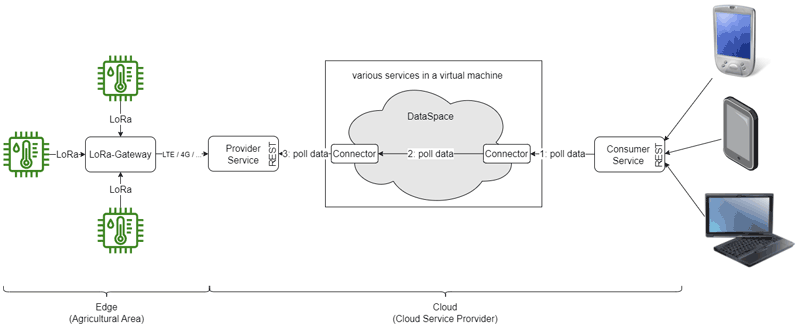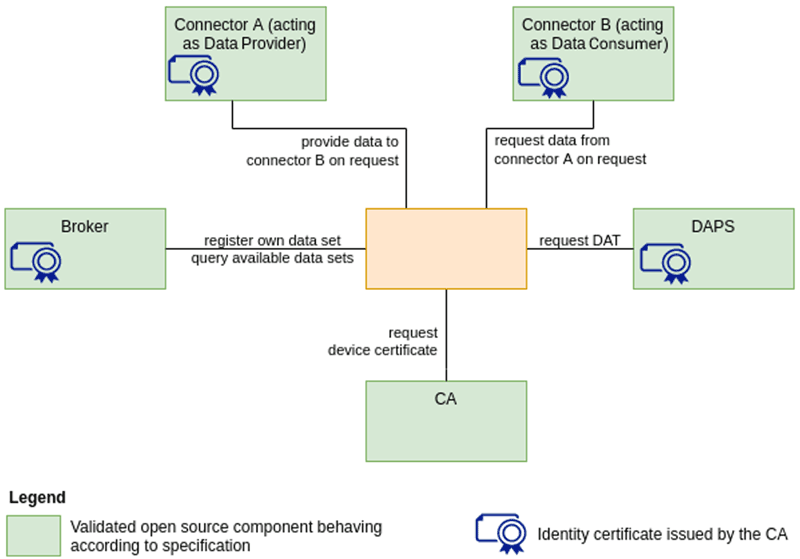by Thomas Ederer, Martin Ivancsits (FH Burgenland) and Igor Ivkić (FH Burgenland, Lancaster University)
Agricultural production is highly dependent on naturally occurring environmental conditions like change of seasons and the weather. Especially in fruit and wine growing, late frosts occurring shortly after the crops have sprouted have the potential to cause massive damage to plants [L1,L2] [1]. In this article we present a cost-efficient temperature monitoring system for detecting and reacting to late frosts to prevent crop failures. The proposed solution includes a data space where Internet of Things (IoT) devices can form a cyber-physical system (CPS) to interact with their nearby environment and securely exchange data. Based on this data, more accurate predictions can be made in the future using machine learning (ML), which will further contribute to minimising economic damage caused by crop failures.
The production of food in agriculture often follows traditional practices, relying on the knowledge passed down from previous generations and on intuition-based decisions. These decisions relate to activities such as sowing, the application of fertilisers, the protection of crops and harvesting. In addition, agriculture is strongly influenced by natural conditions such as location, climate and weather. In sectors such as fruit and wine growing, frosts that occur shortly after crops have started to grow can cause significant damage. As a result, that year's crop is often significantly smaller and of lower quality, leaving the affected farms with some permanent damage. The knock-on effects extend to the market, where such late frosts can lead to scarcer, lower-quality produce and higher prices for consumers. In the most severe cases, some crops may not be available in the local area for an entire season. This requires substitutes to be sourced from distant locations, which increases emissions and has a negative impact on the climate.
Historically, frost damage has been mitigated using a variety of techniques, including water spraying, heaters and fumigation. These methods, while using existing weather systems, are largely manual and often overlook unique local features such as field alignment, wind shelters or nearby water sources. As a result, certain parts of the farm may experience dangerous drops in temperature that can go unnoticed by the system. In anticipation, some farmers employ people to monitor their fields on particularly cold nights, sounding the alarm when temperatures reach critically low levels. Although proactive, this method is expensive, physically demanding and increases the likelihood of human error. In addition, when applying mitigation measures, farmers tend to err on the side of caution and use resources such as water and fuel more liberally than is necessary.
To reduce manual effort in the field and save resources, we present an end-to-end use case of an International Data Space (IDS) [L3] designed for detailed temperature monitoring in agricultural regions [2,3]. The IDS consists of IoT devices with temperature sensors that periodically transmit their data to a long-range (LoRa) gateway via the LoRa wide area network (LoRaWAN). The gateway then transmits this data via long-term evolution (LTE) to a provider service, which is managed by a cloud service provider (CSP). The provider service stores the sensor data and makes it available to other (requesting) IDS members. To ensure that the sensors-owning farm remains in full control of their data, the measurements are not automatically transmitted to other systems. Instead, within the IDS, the data provider only shares its data on request and only with a data consumer that is also part of the same data space. The following figure shows the architecture of the proposed IDS-based Orchard/Vinyard Control (OrViCon) temperature monitoring system.
As shown in Figure 1, the OrViCon architecture consists of temperature sensors on the edge, while the provider service and data space are running in the cloud. The temperature sensors installed in the agricultural area periodically send their data via LoRaWAN [L4] to the LoRa gateway, which then forwards the data to a provider service hosted by a CSP. The provider service adds the GPS coordinates of the corresponding sensor and stores the data for a potential requesting consumer service. The data space provides the necessary connectors to establish a secure end-to-end connection between a consuming service to a data-providing service. This approach guarantees that only data space members have access to certain datasets and that the data is only transmitted securely upon a request from a consumer service.

Figure 1: Architecture of OrViCon.
As shown in Figure 2, the IDS testbed consists of two connector instances: the data provider and the data consumer. The two connector instances are configured manually to specify which dataset can be offered by the data provider, or which dataset can be requested by a data consumer. The proposed OrViCon monitoring system provides a suitable solution for data exchange in agriculture scenarios. A key benefit of the system is that every new member must enrol prior to accessing other services within the data space. Another advantage is that, after successful registration, members are required to choose only from approved (certified) connectors to establish a connection to the data space.

Figure 2: Structure of the IDS testbed.
In conclusion, the data space provides the necessary software architecture to enable sovereign and secure data exchange between registered, trusted members. This ensures that the measurement data provided can only be accessed by certified members within the data space. In addition, data providers can set conditions (or rules) for the measurement data they make available. Potential consumers must agree to these conditions before they can use the data [L7]. The proposed OrViCon monitoring system shown in Figure 1 provides temperature data for an agricultural field that can be used to guide targeted measures against late frost. Based on the measured data, mitigation measures can be localised to specific areas rather than being applied across the entire agricultural landscape. This enables a more precise and economical use of resources such as water and fuel, resulting in reduced pollutant emissions and a positive impact on the climate.
Links:
[L1] https://www.hagel.at/presseaussendungen/spaetfrost-hat-schwere-schaeden-im-obstbau-verursacht/
[L2] https://www.hagel.at/presseaussendungen/lokalaugenschein/
[L3] https://internationaldataspaces.org/
[L4] https://lora-alliance.org/
[L5] https://github.com/International-Data-Spaces-Association/IDS-testbed
[L6] https://github.com/International-Data-Spaces-Association/DataspaceConnectorUI
[L7] https://internationaldataspaces.org/wp-content/uploads/IDS-The-Standard-for-Data-Sovereignty-English.pdf
References:
[1] M. R. Salazar-Gutiérrez, B. Chaves, G. Hoogenboom, G., “Freezing tolerance of apple flower buds”, Scientia Horticulturae, vol. 198, pp. 344–351, 2016.
[2] E. Curry and S. Scerri, T. Tuikka, “Data spaces: design, deployment and future directions”, p. 357, Springer Nature, 2022.
[3] H. Ding, L. Liu, Z. Liang, “Research on environmental monitoring and prediction method of orchard frost based on wireless sensor network”, in Int. Conf. on Guidance, Navigation and Control, pp. 7323–7332, Singapore, Springer Nature Singapore, 2022.
Please contact:
Thomas Ederer and Martin Ivancsits, FH Burgenland, Austria










